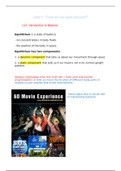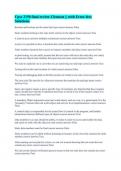Case 6
LG1: What are the different types of movements?
1. Ballistic movement
Maximum velocity in very short period of time
Short duration agonist then antagonist activity → open-loop control
Strong muscle activity
2. Continuous movement
Ag-ant-ag peak
Open-loop control
3. Discontinuous/discrete movement
ONLY agonist activity
Fine and slow movement
Closed-loop control
EMG – ElectroMyoGraphy
It is an experimental technique concerned with development, recording and analysis of myoelectric signals.
Myoelectric signals are formed by physiological variations in the state of muscle fiber membranes it is the
study of muscle function through the inquiry of the electrical signals the muscle emanates.
The electromyograph detects the myoelectric signals that are generated by the muscle cells when they are
neurologically activated.
Myoelectric signal → also called a motor
action potential, is an electrical impulse that
produces contraction of muscle fibers in the
body.
How to interpret the EMG? → What is the
relation between the EMG pattern and the
force pattern?
The electromyogram has several things that
can be read out of it. One of the important
things is that the sEMG amplitude of the
, signal is proportional to the force produced by the muscle, as it represents the amount of muscle fibers that are
active to contract the muscle.
→ This relation between amplitude and force is a linear relation. However, the bigger the muscle, the more this
relation becomes a bit curvy linear. Because of this linear relationship, it is possible to see in which shape a
certain muscle is.
- Atrophy → When a muscle is partial (or complete) wasting away, which has several causes (such as
lack of oxygen)
- Concentric contraction → Contraction that permits the muscle to shorten.
- Static contraction → Contraction without changing the length of the muscle.
- Eccentric contraction → Contraction that permits the muscle to lengthen.
LG2: What are agonist/antagonist muscles?
When discussing movement at a joint, the muscle performing the action on one side
of the joint is called the agonist, and the muscle on the other side of the joint with the
potential to oppose the action is called the antagonist.
LG3: Open and closed loops
CLOSED LOOP MECHANISM
A closed loop mechanism is a system which controls itself over a long period of time. The input of the system’s
goal is provided to a reference mechanism which ten samples the environment that it is attempting to control.
The information of the environment is the feedback of the loop.
The reference mechanism compares the value of the goal and the obtained information of the environment. The
difference – called error – between the two values is computed. This error gets passed onto an executive level
where a decision is made about lowering the error. Is the error large enough, instructions are sent to an effector
level and a mechanism that can affect the value of the environment. The mechanism which controls the
environment is on or off, depending on the goal value and the error.
It is called closed loop because the loop of control from the environment to decisions to action and back to the
environment is completed or closed.
Stimulus identification stage:
The system can receive and process feedback information to determine
movement errors.
Response-programming stage:
The system programs instruction to reduce the error. These instructions are
given to the effector level (muscles) to control the error in movement.
Information obtained from various muscles, joints, tendons, receptors, eyes,
ears, etc. is sent back to the reference mechanism to decide about future actions.
The feedback loop requires attention / consciousness.
Three types of receptors gather sensory information.
1. Interoceptors – give information about the state of our internal organs
& provides information about pain
2. Exteroceptors – provide information about the movement of object in the environment
LG1: What are the different types of movements?
1. Ballistic movement
Maximum velocity in very short period of time
Short duration agonist then antagonist activity → open-loop control
Strong muscle activity
2. Continuous movement
Ag-ant-ag peak
Open-loop control
3. Discontinuous/discrete movement
ONLY agonist activity
Fine and slow movement
Closed-loop control
EMG – ElectroMyoGraphy
It is an experimental technique concerned with development, recording and analysis of myoelectric signals.
Myoelectric signals are formed by physiological variations in the state of muscle fiber membranes it is the
study of muscle function through the inquiry of the electrical signals the muscle emanates.
The electromyograph detects the myoelectric signals that are generated by the muscle cells when they are
neurologically activated.
Myoelectric signal → also called a motor
action potential, is an electrical impulse that
produces contraction of muscle fibers in the
body.
How to interpret the EMG? → What is the
relation between the EMG pattern and the
force pattern?
The electromyogram has several things that
can be read out of it. One of the important
things is that the sEMG amplitude of the
, signal is proportional to the force produced by the muscle, as it represents the amount of muscle fibers that are
active to contract the muscle.
→ This relation between amplitude and force is a linear relation. However, the bigger the muscle, the more this
relation becomes a bit curvy linear. Because of this linear relationship, it is possible to see in which shape a
certain muscle is.
- Atrophy → When a muscle is partial (or complete) wasting away, which has several causes (such as
lack of oxygen)
- Concentric contraction → Contraction that permits the muscle to shorten.
- Static contraction → Contraction without changing the length of the muscle.
- Eccentric contraction → Contraction that permits the muscle to lengthen.
LG2: What are agonist/antagonist muscles?
When discussing movement at a joint, the muscle performing the action on one side
of the joint is called the agonist, and the muscle on the other side of the joint with the
potential to oppose the action is called the antagonist.
LG3: Open and closed loops
CLOSED LOOP MECHANISM
A closed loop mechanism is a system which controls itself over a long period of time. The input of the system’s
goal is provided to a reference mechanism which ten samples the environment that it is attempting to control.
The information of the environment is the feedback of the loop.
The reference mechanism compares the value of the goal and the obtained information of the environment. The
difference – called error – between the two values is computed. This error gets passed onto an executive level
where a decision is made about lowering the error. Is the error large enough, instructions are sent to an effector
level and a mechanism that can affect the value of the environment. The mechanism which controls the
environment is on or off, depending on the goal value and the error.
It is called closed loop because the loop of control from the environment to decisions to action and back to the
environment is completed or closed.
Stimulus identification stage:
The system can receive and process feedback information to determine
movement errors.
Response-programming stage:
The system programs instruction to reduce the error. These instructions are
given to the effector level (muscles) to control the error in movement.
Information obtained from various muscles, joints, tendons, receptors, eyes,
ears, etc. is sent back to the reference mechanism to decide about future actions.
The feedback loop requires attention / consciousness.
Three types of receptors gather sensory information.
1. Interoceptors – give information about the state of our internal organs
& provides information about pain
2. Exteroceptors – provide information about the movement of object in the environment





